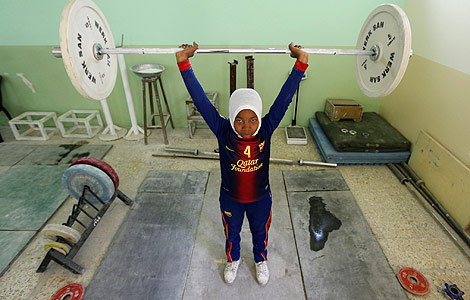Unique calling
Updated: 2013-05-08 00:44
By Xu Lin (China Daily)
|
|||||||||||
In 2007, when she searched the word "dyslexia" on Baidu.com, the largest Chinese search engine, there were about 100 related results. Now there are more than 230,000. As far as she knows, there are about three such centers in China.
She thinks the center's greatest contribution is creating public awareness about dyslexia, and it's also the biggest challenge.
Its public awareness activities include delivering speeches in schools and communities. The Chaoyang district government has also purchased Langlang's training program to help dyslexic children from impoverished families.
During the National People's Congress and Chinese People's Political Consultative Conference in March, a delegate submitted a proposal about the establishment of a national system to identify dyslexia among children and professional training centers.
But there is still a long way to go in China, where dyslexia is still something new to the public.
In Western countries, such as the United States and the United Kingdom, there are policies for those with dyslexia and the members of the public are very familiar with it. The US even has primary schools, middle schools and universities with centers that are exclusively for this group of people.
"It will be a success only when most people know about dyslexia. We need more support and related laws and regulations to help people with dyslexia," she says.
According to Lan, the children are no different from others, and some are genius.
Wu says, "My son may have some difficulties in writing, but has a gift for identifying solid shapes and likes designs very much. I want him to develop what he's good at.
"We need to be patient because it takes time for kids to improve reading and writing abilities. We should understand and tolerate our own children, by appreciating their advantages."
AT A GLANCE
If your child (primary school student) has six of the following symptoms for more than half a year, it's possible that he or she has dyslexia, which is one of the main causes of learning difficulties.
1. Has difficulties in reading and often misreads.
2. Has difficulties in understanding the content after reading.
3. Skips words or lines while reading.
4. Has difficulties in writing and often makes mistakes. Tends to avoid writing and writes in scrawl.
5. Has difficulties in copying Chinese characters. Need to refer to the original character for each stroke.
6. Short attention span.
7. Hyperactive, with a low efficiency in class.
8. Not good at sports, with a bad sense of balance.
9. Poor motor skills. Bad pen-holding position. Laces up one's shoes and uses chopsticks in a clumsy way.
10. Poor interpersonal skills, shy, introvert or impetuous.
11. No self-confidence and gives up easily.
12. Smart but struggles to study.
Langlang Learning Potential Development Center
Related Stories
How to read the signposts of Life 2013-04-28 09:13
Books study whether students are reading 2013-04-28 05:46
Time to read even the fine print 2013-04-26 08:17
Reading rate falling in China 2013-04-19 16:35
3rd annual reading season starts in Beijing 2013-04-12 18:18
Getting kids hooked on reading with mystery 2013-04-07 11:19
Today's Top News
Detention of petitioners denounced
Lawyers get an advocate
Pentagon accusation on China's military rejected
Foster homes for homeless children
Public hearing to discuss taxi fare increase
21 Party officials, SOE managers disciplined
Clarity on tax evasion needed, lawmakers told
Visa policy to attract global tourists
Hot Topics
Lunar probe , China growth forecasts, Emission rules get tougher, China seen through 'colored lens', International board,
Editor's Picks

|

|

|

|

|

|





